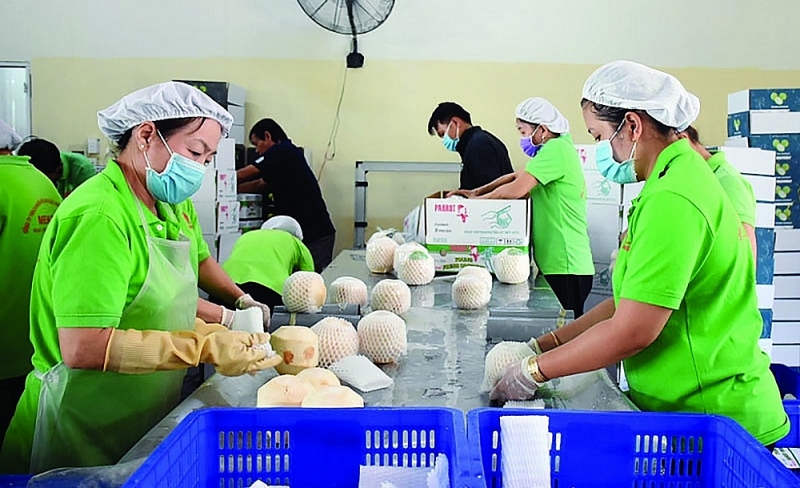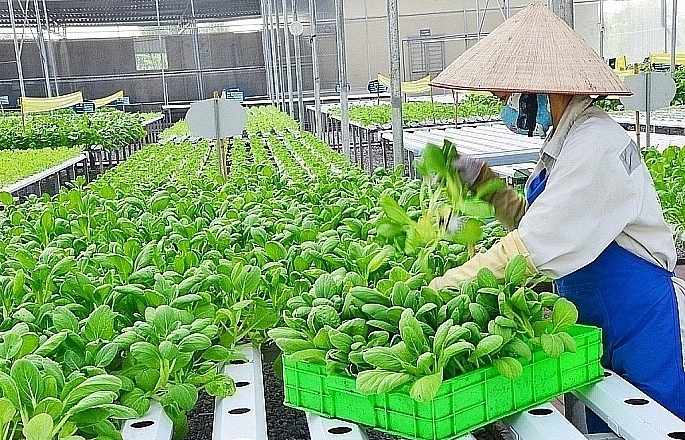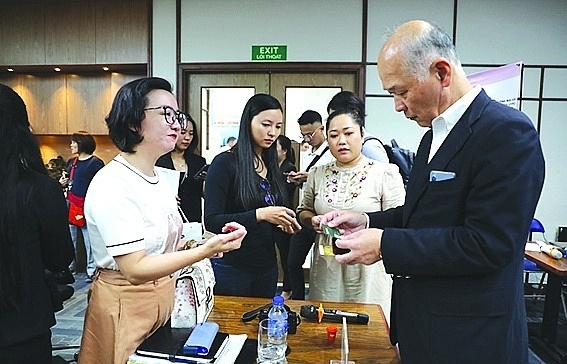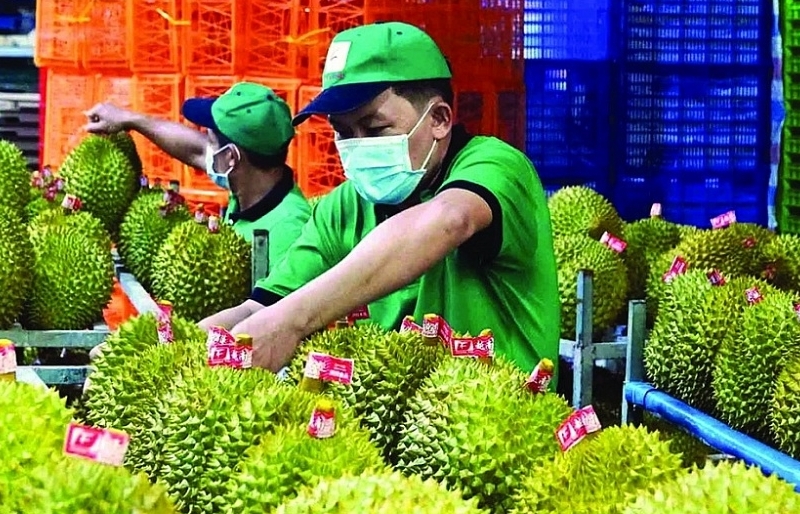Enhancing the competitiveness of Vietnamese agricultural products in the US and EU with quality and reputation
 |
| Vietnamese coconuts are having many opportunities to export to European and American markets. Illustration photo. |
Losing opportunity unless going fast
According to data from the Ministry of Industry and Trade, after 2 years of implementing the Vietnam-EU Free Trade Agreement (EVFTA), Vietnam's ability to take advantage of it has only reached 12.1%.
At the seminar “Connecting information about needs, tastes and disseminating agricultural product market regulations in the EU - US region” held last weekend, Ms. Nguyen Thuy Linh, Department of International Cooperation, Ministry of Agriculture and Rural Development pointed out 3 reasons to explain the question that EVFTA bought outstanding incentives but the level of exploitation was low. First, limitations in logistics and transportation make Vietnamese businesses prefer nearby markets. Second, due to the large difference in standards and quality management between Vietnam and Europe, Vietnamese enterprises have the mentality of prioritizing markets with similar standards. Third, enterprises also prioritize choosing markets with similar consumer awareness, while the European market had many differences compared to Vietnam.
The above limitations also show that there was still great room for Vietnamese agricultural products in the EU market. However, Ms. Linh also noted that if incentives from EVFTA were not taken quickly, the opportunity might be lost because the EU was preparing to end FTA negotiations with Thailand. While they were a formidable competitor for many Vietnamese products, if there was an FTA, Thai products would certainly develop very quickly in the EU.
Looking back at the recent reality, the lack of an FTA with the EU makes Thai goods be subject to very high MFN tax rates, an average of 5-7%, and even processed goods are subject to a tax rate of up to 25%. while Vietnamese goods enjoy a tax rate of 0%. However, Thailand is still a strong competitor of Vietnam in this market for many products such as mango, longan, rambutan, processed foods...
Regarding the US market, Mr. Nguyen Nhu Phong, Deputy Director of the Institute of Policy and Strategy for Rural Development, Ministry of Agriculture and Rural Development, assessed that although Vietnamese agricultural and food products had very high growth in recent years which helped Vietnam become the fourth source of agricultural products and food here, the proportion was still very modest and Vietnamese agricultural products were mainly exported raw ones with uncompetitive prices. The distribution channels for that Vietnamese agricultural and food products were also very limited, mainly purchasing companies. While Vietnam had not accessed processing companies, wholesale and retail organizations.
According to Mr. Phong, access to information about the US market was still quite limited. Although Vietnam had an agricultural counselor in the US, helping to provide information quite quickly and completely, the information that deployed to small and medium-sized enterprises and producers in rural areas was still quite limited. Besides, the US market also had potential risks regarding tariff and non-tariff protection policies...
Many points to note
In fact, in recent times the domestic agricultural industry has had strategic transformations, changing its thinking from agricultural production to agricultural economics. Accordingly, development has focused on high-value products, increasing added value through preliminary processing, processing, developing ecological agriculture, organic agriculture and recently a commitment to Carbon emission reduction is also included in agricultural and rural development strategies and the development of commodity industries. These changes help the agricultural sector improve its ability to meet the technical requirements of major export markets and diversify markets.
To improve the turnover and position of Vietnam's agricultural, forestry and fishery products in the EU market, Ms. Nguyen Thuy Linh said that in the Project to promote the export of agricultural, forestry and fishery products to the EU market until 2030, the Ministry of Agriculture and Rural Development launched a new approach focusing on improving quality, stabilizing supply and traceability for agricultural, forestry and fishery products. At the same time, reorganizing all trade promotion activities to ensure better connections and bring greater efficiency; Developing distribution channels and enhancing information, ensuring timely communication from representative agencies in the EU to ministries, branches, associations and enterprises. “We no longer focus on price but aim at the overall value of the product, sustainability and responsibility to build prestige and trust”, Ms. Linh emphasized.
In the US market, Mr. Nguyen Nhu Phong proposed solutions to strengthen negotiations to open the market with the US to export products with competitive advantages of Vietnam such as vegetables, fruits, and seafood; Ensure access to early information and early warnings to handle trade disputes in the fields of agriculture, forestry and fisheries. To do this, state management agencies played an important role, including the Ministry of Industry and Trade, the Ministry of Agriculture and Rural Development, and counselors in the US market.
In particular, in developing distribution channels, Mr. Phong believed that it was necessary to negotiate the opening of bonded warehouses with storage systems that meet preservation standards for agricultural products in populous and economically developed states of the US to participate in trade promotion activities and e-commerce development in this market. “This is quite challenging, but if done, it will contribute to reducing risks in the process of transporting agricultural products such as freight price fluctuations and lack of containers”, Mr. Phong said.
As for enterprises, Ms. Tran Thuy Dung, Standing Department, Southern Plant Protection Department in Ho Chi Minh City, said that the growing area code, packaging facility code and plant quarantine certificate were basic requirements that enterprises must pay attention to export to the EU. Ms. Dung also noted that there were many agencies and private units providing services of issuing planting area codes and packaging facility codes. However, there was only one Vietnamese authority recognized by the EU to issue these codes as well as plant quarantine certificates, it was the Plant Protection Department. Therefore, if enterprises had a need, they had to contact directly and the Plant Protection Department would directly go to growing areas and packaging facilities to check whether they meet EU requirements.
Notably, some EU plant quarantine objects are present in Vietnam, even quite common such as fall armyworms, fruit flies, earworms, leaf flies, corn worms... Types of worms needs to be completely removed from the shipment before exporting to the EU market.
Regarding the residue issue, Ms. Dung said that EU and US regulations were constantly being adjusted. In 2023 alone, the EU had announced 120 changes to residue levels. To update this information, enterprises could contact the Vietnam SPS Office, the Department of Quality, Processing and Market Development, or on the website of the Plant Protection Department, which also regularly updated regulations. changes in countries.
Meanwhile, the United States required all fruits exported to this market to be irradiated. However, currently the United States had only approved two irradiation factories including Son Son and Toan Phat in the South to irradiate fruit products for export to the United States. Currently, the Ministry of Agriculture and Rural Development was trying to negotiate for the United States to approve a factory in the North to provide irradiation services, helping to save time and transportation and warehousing costs for Vietnamese exported fruits.
Related News

Hanoi: Maximum support for affiliating production and sustainable consumption of agricultural products
09:43 | 25/12/2024 Import-Export

Ho Chi Minh City: Diversifying forms of support for businesses exporting goods
09:42 | 25/12/2024 Headlines

Hong Kong: A gateway for Vietnamese businesses to access the Greater Bay Area market
09:04 | 24/12/2024 Import-Export

Paving the way for Vietnamese agricultural products in China
11:08 | 26/12/2024 Import-Export
Latest News

Nghệ An Province anticipates record FDI amidst economic upswing
15:49 | 26/12/2024 Import-Export

Green farming development needs supportive policies to attract investors
15:46 | 26/12/2024 Import-Export

Vietnamese enterprises adapt to green logistics trend
15:43 | 26/12/2024 Import-Export

VN seafood export surpass 2024 goal of $10 billion
14:59 | 25/12/2024 Import-Export
More News

Exporters urged to actively prepare for trade defence investigation risks when exporting to the UK
14:57 | 25/12/2024 Import-Export

Electronic imports exceed $100 billion
14:55 | 25/12/2024 Import-Export

Forestry exports set a record of $17.3 billion
14:49 | 25/12/2024 Import-Export

Việt Nam boosts supporting industries with development programmes
13:56 | 24/12/2024 Import-Export

VN's wood industry sees chances and challenges from US new trade policies
13:54 | 24/12/2024 Import-Export

Vietnam's fruit, vegetable exports reach new milestone, topping 7 billion USD
13:49 | 24/12/2024 Import-Export

Aquatic exports hit 10 billion USD
13:45 | 24/12/2024 Import-Export

UK a niche market for Vietnamese speciality coffee
14:11 | 23/12/2024 Import-Export

Vietnam-US trade thrives on effective mechanisms: trade counsellor
14:08 | 23/12/2024 Import-Export
Your care

Nghệ An Province anticipates record FDI amidst economic upswing
15:49 | 26/12/2024 Import-Export

Green farming development needs supportive policies to attract investors
15:46 | 26/12/2024 Import-Export

Vietnamese enterprises adapt to green logistics trend
15:43 | 26/12/2024 Import-Export

Paving the way for Vietnamese agricultural products in China
11:08 | 26/12/2024 Import-Export

VN seafood export surpass 2024 goal of $10 billion
14:59 | 25/12/2024 Import-Export





